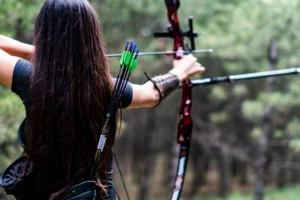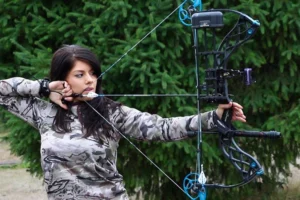Drawing a compound bow is a fundamental skill for archers, and mastering this process is essential for achieving accuracy and maintaining proper form. In this guide, we will break down the steps required to draw a compound bow effectively.

Whether you’re a beginner or looking to refine your technique, understanding these steps is crucial for your archery journey.
Adjusting Draw Length for Precision
Before you embark on drawing your compound bow, it’s vital to ensure that the bow’s specifications are tailored to your personal needs. One critical specification to consider is the draw length.
This distance is adjustable on most modern compound bows, allowing you to fine-tune it to your physique.
To determine your ideal draw length, seek assistance from a qualified individual who can measure you accurately.
Failing to adjust your bow to the correct draw length can negatively impact your shooting form. It may make it challenging to anchor properly or hold the bow comfortably at full draw while maintaining proper upper body alignment.
Optimizing Draw Weight for Performance
Another crucial specification to set correctly is the draw weight of your compound bow. While a draw weight that’s too light is generally not an issue, an overly heavy draw weight can make drawing your bow extremely difficult and lead to accuracy issues.
You can adjust the draw weight by turning the bow’s limb bolts, usually with the aid of a scale and Allen wrenches.
Many bows on the market offer versatile draw weight settings that can significantly vary based on the chosen adjustment.
Excessive draw weight can cause archers to struggle when drawing the bow, leading to improper form and potential physical injury.
Step-by-Step Guide to Drawing a Compound Bow
Drawing a compound bow is a multistep process that, when followed correctly, results in ease, proper form, and safety. Here’s a detailed breakdown of each step:
- Nock Arrow and Connect Release: Begin by nocking an arrow and connecting your release aid to the string’s D-loop. Ensure that the arrow is securely positioned in its rest before proceeding.
- Line Body Up With Target: Determine your aiming point and adjust your body’s angle accordingly. Align your downrange-facing hip with the target, keeping the other hip facing in the opposite direction.
- Set Your Stance: While not everyone’s stance is the same, a common starting point is having your feet shoulder-width apart. You can later adjust your stance for comfort once you become more familiar with the basics.
- Raise Bow Arm To Target Level: Lift the arm responsible for holding the bow, aligning it at an outward angle. Your bow arm’s level should be approximately at nose height.
- Slightly Raise Opposite Arm: Before pulling on the bowstring, slightly raise your non-bow arm. Ensure that your release arm’s elbow faces outward and behind you rather than pointing sharply downward.
- Draw Rearward: Maintain your extended bow arm while smoothly and precisely pulling the bowstring backward. Your non-bow arm’s elbow should rise slightly before settling into a more even position upon reaching full draw. Your torso will naturally rotate as you draw.
- Anchor Your Non-Bow Arm: Once at full draw, anchor your hand with the release aid. Most archers prefer placing their hand along their cheek, with their head turned toward the target.
- Check Upper Body Geometry: Examine the geometry of your upper body. Your body and both arms should form a “T” shape, with each arm forming a 90-degree angle to your body. If aiming downward, any bending should occur at the waist.
- Check for Bow Arm String Clearance: Before releasing your shot, ensure that your bow arm is clear of the bowstring’s path. Some archers lock their elbow, while others leave it slightly bent. The choice depends on your clearance requirements.
Drawing Your Bow with Confidence
Drawing a compound bow may initially seem daunting, but it becomes a straightforward process once you follow these steps.
Ensuring that your bow’s draw weight and draw length are adjusted to your specific needs is essential.
With practice and adherence to these steps, you’ll build correct shooting habits, improve accuracy, and minimize safety risks. Remember, proper form and technique are the keys to success in archery.
Choosing the Right Equipment
Selecting the appropriate equipment for your archery endeavors is a pivotal step in ensuring a successful draw. Here are some factors to consider:
- Bow Type: Compound bows offer a mechanical advantage over traditional bows due to their pulley system, making them easier to draw and hold at full draw. Consider starting with a compound bow if you’re new to archery.
- Arrow Selection: The type of arrows you use can impact your draw and overall performance. Ensure your arrows match your bow’s draw weight and length specifications.
- Release Aid: A release aid can help you maintain consistent and controlled shots. There are various types of releases available, including wrist strap releases and thumb-trigger releases. Experiment with different options to find the one that suits you best.
- Sights and Accessories: Adding sights, stabilizers, and other accessories can enhance your accuracy. These tools assist in aiming and reducing bow movement while aiming.
Proper Warm-Up and Stretching
Before you draw your bow, it’s crucial to prepare your body to avoid strain or injury. Here’s a quick warm-up routine to consider:
- Shoulder and Arm Rotations: Gently rotate your shoulders and arms to loosen the muscles. This helps improve your range of motion.
- Neck and Back Stretches: Perform neck and back stretches to alleviate tension and promote flexibility.
- Wrist and Hand Exercises: Since your hands are crucial in archery, perform wrist and hand exercises to ensure they are limber and ready for action.
- Breathing Exercises: Practicing controlled breathing can help you remain calm and focused during the draw and release.
Consistency and Practice
Drawing a compound bow proficiently requires consistent practice. Here are some tips to enhance your skills:
- Regular Practice Sessions: Dedicate time to regular practice sessions to build muscle memory and improve your draw technique.
- Record Your Progress: Use video recording to assess your form and identify areas for improvement. Analyzing your shots can be a valuable learning tool.
- Seek Guidance: Consider taking lessons or seeking advice from experienced archers or coaches. They can provide valuable insights and correct any form errors.
- Vary Your Practice: Experiment with different distances, targets, and shooting scenarios to simulate real-world conditions.
Safety Precautions
Archery can be a safe sport when practiced correctly, but it’s crucial to prioritize safety. Here are some essential safety precautions:
- Inspect Your Equipment: Regularly check your bow, arrows, and release aid for any signs of damage or wear. Faulty equipment can lead to accidents.
- Always Use an Archery Range: Practice at a designated archery range to ensure a safe environment with proper backstops and targets.
- Never Dry Fire: Never release the bowstring without an arrow nocked. Dry firing can damage the bow and pose safety risks.
- Wear Appropriate Gear: Use safety gear like an arm guard and finger tab or release aid to protect yourself from string slap or pinching.
By incorporating these additional sections into your knowledge of how to draw a compound bow properly, you’ll be better equipped to excel in archery while prioritizing safety, technique, and ongoing improvement. Remember that archery is a skill that takes time to master, so stay patient and persistent in your pursuit of excellence.
Final Thoughts
Drawing a compound bow is a journey of discipline and precision. Remember to be patient, prioritize safety, seek knowledge, and respect the tradition of archery. Listen to your body, nurture your mental game, and embrace the journey itself.
Archery is not just about hitting targets; it’s about the experience and personal growth it brings. Enjoy every moment spent honing your skills.



